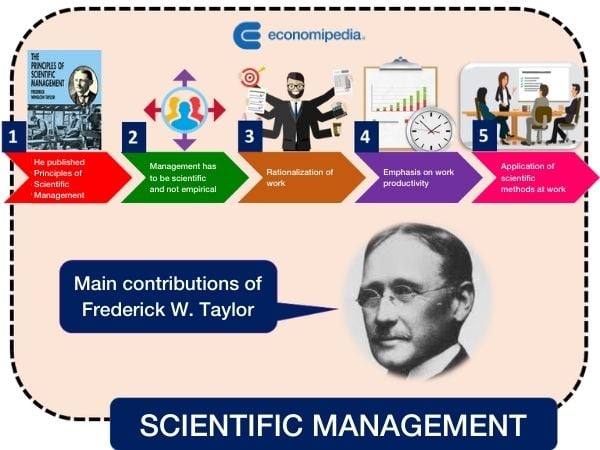Scientific management
Scientific management is concerned with the study of the causes and effects of problems affecting an organisation. It uses systematised knowledge and applies scientific methods such as observation and measurement to improve the efficiency of organisations.
Indeed, scientific management began in the late 19th and early 20th century. When the changes brought about by the process of the Industrial Revolution caused the processes in companies to change radically.
Above all, managers realised that the empirical knowledge of management was no longer sufficient to provide answers to the new problems that arose. This led to the emergence of scientific management.
Of course, what was sought was to give a scientific approach to the management problems faced by an organisation. The scientific approach emerged at the beginning of the 20th century with the contributions of Frederick W. Taylor in the United States. His main contribution was the principle of rationalisation of work.
Frederick W. Taylor’s main contributions to scientific management
Frederick W. Taylor is known as the father of scientific management, as he was the first to make the first contributions to this school.
Its main contributions are:
- He published Principles of Scientific Administration in 1911.
- He argues that management should be studied scientifically and not empirically.
- It establishes the rationalisation of work by means of time and motion studies.
- It emphasises the productivity of labour and proposes that workers should be paid according to their productivity.
- It proposes better methods for work performance with the application of scientific methods at work.

Principles of scientific management
The principles of scientific management proposed by Taylor are:
1. The study and scientific organisation of work
Firstly, this principle refers to the fact that managers must replace inefficient working methods, considering times, delays, movements, operations performed and tools used.
Therefore, this process should be elaborated by a group of specialists, who will be responsible for defining the most efficient and economical operational processes. The amount of work to be done by each person under optimal conditions should be established. The more productive a worker is, the better he/she should be paid.
It should be noted that this principle is related to the planning process, it seeks to change improvisation into scientific planning of working methods.
2. Selection and training of workers
Secondly, this principle aims to place the most suitable worker for each type of work. This should take into account the worker’s capabilities and provide basic conditions of well-being at work.
In other words, the aim is to have the minimum requirements that the worker must possess to perform a task efficiently. This selection should be carried out systematically, since the better prepared a person is to carry out a task, the more productive he/she will be.
Naturally, it is related to the principle of scientific preparation of workers, which will help them to produce more and better. It is about scientifically selecting workers according to the planned method.
3. Cooperative action between management and workers
Thirdly, this principle aims to ensure that the interests of the workers and the employer are the same. To achieve this, it proposes that labour remuneration should be based on the productivity of the worker. So that the worker who produces the most earns the most.
This implies that work and responsibilities are divided equally between leaders and workers. To achieve this requires:
- Remuneration per unit of output.
- Superiors who train their workers in each area of specialisation.
- Division of labour of leaders and workers.
This is also related to the principle of control because superiors must verify that the execution of tasks is carried out in the best possible way.
4. Responsibility and specialisation of superiors in work planning
Of course, the superiors do the mental work and the workers do the manual work, thus achieving the division and specialisation of labour. The division of labour enables work to be carried out more efficiently. Tasks are assigned to be performed in a scientific and disciplined manner.

Advantages of scientific management
Among the most important advantages of scientific management are the following:
- A higher level of job specialisation is achieved.
- The work of each worker is carried out more efficiently.
- Better results are achieved through the application of division of labour.
- The difference between mental and manual labour is established.
- It increases productivity by remunerating workers according to what they produce.
- Promotes the personal development of workers.
Disadvantages of scientific administration
The most important disadvantages are the following:
- The line of communication is downward, so workers are not able to contribute and have a say.
- Unity of command is lost and generates conflict among the workers.
- Individualism is promoted to maximise efficiency.
In conclusion, we can affirm that scientific management establishes that the scientific method must be applied to solve administrative problems. For Taylor, the most important thing was to increase labour productivity. This was achieved through the division and specialisation of tasks. But above all, using wage incentives.

